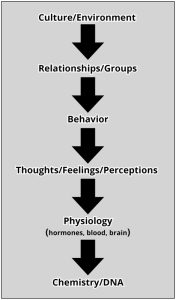1
The science of social psychology investigates the ways other people affect our thoughts, feelings, and behaviors. It is an exciting field of study because it is so familiar and relevant to our day-to-day lives. Social psychologists study a wide range of topics that can roughly be grouped into 5 categories: attraction, attitudes, peace & conflict, social influence, and social cognition.
Learning Objectives
- Define social psychology and understand how it is different from other areas of psychology.
- Understand “levels of analysis” and why this concept is important to science.
- List at least three major areas of study in social psychology.
- Define the “need to belong”.
Introduction
We live in a world where, increasingly, people of all backgrounds have smart phones. In economically developing societies, cellular towers are often less expensive to install than traditional landlines. In many households in industrialized societies, each person has his or her own mobile phone instead of using a shared home phone. As this technology becomes increasingly common, curious researchers have wondered what effect phones might have on relationships. Do you believe that smart phones help foster closer relationships? Or do you believe that smart phones can hinder connections? In a series of studies, researchers have discovered that the mere presence of a mobile phone lying on a table can interfere with relationships. In studies of conversations between both strangers and close friends—conversations occurring in research laboratories and in coffee shops—mobile phones appeared to distract people from connecting with one another. The participants in these studies reported lower conversation quality, lower trust, and lower levels of empathy for the other person (Przybylski & Weinstein, 2013). This is not to discount the usefulness of mobile phones, of course. It is merely a reminder that they are better used in some situations than they are in others. It is also a real-world example of how social psychology can help produce insights about the ways we understand and interact with one another.

Social psychology is the branch of psychological science mainly concerned with understanding how the presence of others affects our thoughts, feelings, and behaviors. It is important to note that people do not have to be real to influence our thoughts, feelings and behaviors. People can be imagined or implied. Imagine that you are thinking about an upcoming presentation that you must deliver to a room full of colleagues. Your heart starts racing even though you are in your office all alone. This is because the anticipation of social events as well as the recollection of past social events can have an important impact on our present selves.
Social psychology is different than other areas of psychology. For example, personality psychologists focus on individual differences in various domains (e.g., traits, goals) while social psychologists focus on the role of the situation, but these two domains of psychology often intertwine as individual factors often interact with social situations. Clinical psychology focuses on mental disorders and their treatment, and many clinnical psychologists engage in the practice of clinical psychology, which involves treating patients in individual or group therapy settings. On the contrary, social psychologists do not typically study clinical patients and do not professionally engage in therapeutic practices yet social psychology theories can be used to develop new therapeutic interventions. Developmental psychology investigates the way people change across their lifespan whereas social psychologists are more interested in the way people change across different social contexts that are not necessary separated in time. As the name suggests, social psychological science is all about investigating the ways groups function, the costs and benefits of social status, the influences of culture, and all the other psychological processes involving two or more people.
Social psychology is such an exciting science precisely because it tackles issues that are so familiar and so relevant to our everyday life. Humans are “social animals.” Like bees and deer, we live together in groups. Unlike those animals, however, people are unique, in that we care a great deal about our relationships. In fact, a classic study of life stress found that the most stressful events in a person’s life—the death of a spouse, divorce, and going to jail—are so painful because they entail the loss of relationships (Holmes & Rahe, 1967). We spend a huge amount of time thinking about and interacting with other people, and researchers are interested in understanding these thoughts and actions. Giving up a seat on the bus for another person is an example of social psychology. So is disliking a person because he is wearing a shirt with the logo of a rival sports team. Flirting, conforming, arguing, trusting, competing—these are all examples of topics that interest social psychology researchers.
At times, science can seem abstract and far removed from the concerns of daily life. When neuroscientists discuss the workings of the anterior cingulate cortex, for example, it might sound important. But the specific parts of the brain and their functions do not always seem directly connected to the stuff you care about: parking tickets, holding hands, or getting a job. Social psychology feels so close to home because it often deals with universal psychological processes to which people can easily relate. For example, people have a powerful need to belong (Baumeister & Leary, 1995). It doesn’t matter if a person is from Israel, Mexico, or the Philippines; we all have a strong need to make friends, start families, and spend time together. We fulfill this need by doing things such as joining teams and clubs, wearing clothing that represents “our group,” and identifying ourselves based on national or religious affiliation. It feels good to belong to a group. Research supports this idea. In a study of the most and least happy people, the differentiating factor was not gender, income, or religion; it was having high-quality relationships (Diener & Seligman, 2002). Even introverts report being happier when they are in social situations (Pavot, Diener & Fujita, 1990). Further evidence can be found by looking at the negative psychological experiences of people who do not feel they belong. People who feel lonely or isolated are more vulnerable to depression and problems with physical health (Cacioppo, & Patrick, 2008).

Social Psychology is a Science
The need to belong is also a useful example of the ways the various aspects of psychology fit together. Psychology is a science that can be sub-divided into specialties such as “abnormal psychology” (the study of mental illness) or “developmental psychology” (the study of how people develop across the life span). In daily life, however, we don’t stop and examine our thoughts or behaviors as being distinctly social versus developmental versus personality-based versus clinical. In daily life, these all blend together. For example, the need to belong is rooted in developmental psychology. Developmental psychologists have long paid attention to the importance of attaching to a caregiver, feeling safe and supported during childhood, and the tendency to conform to peer pressure during adolescence. Similarly, clinical psychologists—those who research mental disorders– have pointed to people feeling a lack of belonging to help explain loneliness, depression, and other psychological pains. In practice, psychologists separate concepts into categories such as “clinical,” “developmental,” and “social” largely because of scientific necessity to highlight how each psychological sub-discipline has its own unique approaches to research. You may have noticed that this is almost always how psychology is taught, as well. You take a course in personality, another in human sexuality, and a third in gender studies, as if these topics are unrelated. In day-to-day life, however, these distinctions do not actually exist, and there is heavy overlap between the various areas of psychology.

In psychology, there are varying levels of analysis. Figure 1 summarizes the different levels at which scientists might understand a single event. Take the example of a toddler watching her mother make a phone call: the toddler is curious, and is using observational learning to teach herself about this machine called a telephone. At the most specific levels of analysis, we might understand that various neurochemical processes are occurring in the toddler’s brain. We might be able to use imaging techniques to see that the cerebellum, among other parts of the brain, is activated with electrical energy. If we could “pull back” our scientific lens, we might also be able to gain insight into the toddler’s own experience of the phone call. She might be confused, interested, or jealous. Moving up to the next level of analysis, we might notice a change in the toddler’s behavior: during the call she furrows her brow, squints her eyes, and stares at her mother and the phone. She might even reach out and grab at the phone. At still another level of analysis, we could see the ways that her relationships enter into the equation. We might observe, for instance, that the toddler frowns and grabs at the phone when her mother uses it, but plays happily and ignores it when her stepbrother makes a call. All of these chemical, emotional, behavioral, and social processes occur simultaneously. None of them is the objective truth. Instead, each offers clues into better understanding what, psychologically speaking, is happening.
Social psychologists attend to all levels of analysis but—historically—this branch of psychology has emphasized the higher levels of analysis. Researchers in this field are drawn to questions related to relationships, groups, and culture. This means that they frame their research hypotheses in these terms. Imagine for a moment that you are a social researcher. In your daily life, you notice that older men on average seem to talk about their feelings less than do younger men. You might want to explore your hypothesis by recording natural conversations between males of different ages. This would allow you to see if there was evidence supporting your original observation. It would also allow you to begin to sift through all the factors that might influence this phenomenon: What happens when an older man talks to a younger man? What happens when an older man talks to a stranger versus his best friend? What happens when two highly educated men interact versus two working class men? Exploring each of these questions focuses on interactions, behavior, and culture rather than on perceptions, hormones, or DNA.

In part, this focus on complex relationships and interactions is one of the things that makes research in social psychology so difficult. High quality research often involves the ability to control the environment, as in the case of laboratory experiments. The research laboratory, however, is artificial, and what happens there may not translate to the more natural circumstances of life. This is why social psychologists have developed their own set of unique methods for studying attitudes and social behavior. For example, they use naturalistic observation to see how people behave when they don’t know they are being watched. Whereas people in the laboratory might report that they personally hold no racist views or opinions (biases most people wouldn’t readily admit to), if you were to observe how close they sat next to people of other ethnicities while riding the bus, you might discover a behavioral clue to their actual attitudes and preferences.
What is Included in Social Psychology?
Social psychology is the study of group processes: how we behave in groups, and how we feel and think about one another. While it is difficult to summarize the many areas of social psychology research, it can be helpful to lump them into major categories as a starting point to wrap our minds around. There is, in reality, no specific number of definitive categories, but for the purpose of illustration, let’s use five. Most social psychology research topics fall into one (but sometimes more) of each of these areas:
Attraction
A large amount of study in social psychology has focused on the process of attraction. Think about a young adult going off to college for the first time. He takes an art history course and sits next to a young woman he finds attractive. This feeling raises several interesting questions: Where does the attraction come from? Is it biological or learned? Why do his standards for beauty differ somewhat from those of his best friend? The study of attraction covers a huge range of topics. It can begin with first impressions, then extend to courtship and commitment. It involves the concepts of beauty, sex, and evolution. Attraction researchers might study stalking behavior. They might research divorce or remarriage. They might study changing standards of beauty across decades.

In a series of studies focusing on the topic of attraction, researchers were curious how people make judgments of the extent to which the faces of their friends and of strangers are good looking (Wirtz, Biswas-Diener, Diener & Drogos, 2011). To do this, the researchers showed a set of photographs of faces of young men and women to several assistants who were blind to the research hypothesis. Some of the people in the photos were Caucasian, some were African-American, and some were Maasai, a tribe of traditional people from Kenya. The assistants were asked to rate the various facial features in the photos, including skin smoothness, eye size, prominence of cheekbones, symmetry (how similar the left and the right halves of the face are), and other characteristics. The photos were then shown to the research participants—of the same three ethnicities as the people in the photos—who were asked to rate the faces for overall attractiveness. Interestingly, when rating the faces of strangers, white people, Maasai, and African-Americans were in general agreement about which faces were better looking. Not only that, but there was high consistency in which specific facial features were associated with being good looking. For instance, across ethnicities and cultures, everyone seemed to find smooth skin more attractive than blemished skin. Everyone seemed to also agree that larger chins made men more attractive, but not women.
Then came an interesting discovery. The researchers found that Maasai tribal people agreed about the faces of strangers—but not about the faces of people they knew! Two people might look at the same photo of someone they knew; one would give a thumbs up for attractiveness, the other one, not so much. It appeared that friends were using some other standard of beauty than simply nose, eyes, skin, and other facial features. To explore this further, the researchers conducted a second study in the United States. They brought university students into their laboratory in pairs. Each pair were friends; some were same-sex friends and some were opposite-sex friends. They had their photographs taken and were then asked to privately rate each other’s attractiveness, along with photos of other participants whom they did not know (strangers). Friends were also asked to rate each other on personality traits, including “admirable,” “generous,” “likable,” “outgoing,” “sensitive,” and “warm.”
In doing this, the researchers discovered two things. First, they found the exact same pattern as in the earlier study: when the university students rated strangers, they focused on actual facial features, such as skin smoothness and large eyes, to make their judgments (whether or not they realized it). But when it came to the hotness-factor of their friends, these features appeared not to be very important. Suddenly, likable personality characteristics were a better predictor of who was considered good looking. This makes sense. Attractiveness is, in part, an evolutionary and biological process. Certain features such as smooth skin are signals of health and reproductive fitness—something especially important when scoping out strangers. Once we know a person, however, it is possible to swap those biological criteria for psychological ones. People tend to be attracted not just to muscles and symmetrical faces but also to kindness and generosity. As more information about a person’s personality becomes available, it becomes the most important aspect of a person’s attractiveness.
Understanding how attraction works is more than an intellectual exercise; it can also lead to better interventions. Insights from studies on attraction can find their way into public policy conversations, couples therapy, and sex education programs.
Attitudes

Social psychology shares with its intellectual cousins sociology and political science an interest in attitudes. Attitudes are opinions, feelings, and beliefs about a person, concept, or group. People hold attitudes about all types of things: the films they see, political issues, and what constitutes a good date. Social psychology researchers are interested in what attitudes people hold, where these attitudes come from, and how they change over time. Researchers are especially interested in social attitudes people hold about categories of people, such as the elderly, military veterans, or people with mental disabilities.
Among the most studied topics in attitude research are stereotyping and prejudice. Although people often use these words interchangeably, they are actually different concepts. Stereotyping is a way of using information shortcuts about a group to effectively navigate social situations or make decisions. For instance, you might hold a stereotype that elderly people are physically slower and frailer than twenty-year-olds. If so, you are more likely to treat interactions with the elderly in a different manner than interactions with younger people. Although you might delight in jumping on your friend’s back, punching a buddy in the arm, or jumping out and scaring a friend you probably do not engage in these behaviors with the elderly. Stereotypical information may or may not be correct. Also, stereotypical information may be positive or negative. Regardless of accuracy, all people use stereotypes, because they are efficient and inescapable ways to deal with huge amounts of social information. It is important to keep in mind, however, that stereotypes, even if they are correct in general, likely do not apply to every member of the group. As a result, it can seem unfair to judge an individual based on perceived group norms.
Prejudice, on the other hand, refers to how a person feels about an individual based on their group membership. For example, someone with a prejudice against tattoos may feel uncomfortable sitting on the metro next to a young man with multiple, visible tattoos. In this case, the person is pre-judging the man with tattoos based on group members (people with tattoos) rather than getting to know the man as an individual. Like stereotypes, prejudice can be positive or negative.
Discrimination occurs when a person is biased against an individual, simply because of the individual’s membership in a social category. For instance, if you were to learn that a person has gone to rehabilitation for alcohol treatment, it might be unfair to treat him or her as untrustworthy. You might hold a stereotype that people who have been involved with drugs are untrustworthy or that they have an arrest record. Discrimination would come when you act on that stereotype by, for example, refusing to hire the person for a job for which they are otherwise qualified. Understanding the psychological mechanisms of problems like prejudice can be the first step in solving them.
Social psychology focuses on basic processes, but also on applications. That is, researchers are interested in ways to make the world a better place, so they look for ways to put their discoveries into constructive practice. This can be clearly seen in studies on attitude change. In such experiments, researchers are interested in how people can overcome negative attitudes and feel more empathy towards members of other groups. Take, for example, a study by Daniel Batson and his colleagues (1997) on attitudes about people from stigmatized groups. In particular, the researchers were curious how college students in their study felt about homeless people. They had students listen to a recording of a fictitious homeless man—Harold Mitchell—describing his life. Half of the participants were told to be objective and fair in their consideration of his story. The other half were instructed to try to see life through Harold’s eyes and imagine how he felt. After the recording finished, the participants rated their attitudes toward homeless people in general. They addressed attitudes such as “Most homeless people could get a job if they wanted to,” or “Most homeless people choose to live that way.” It turns out that when people are instructed to have empathy—to try to see the world through another person’s eyes—it gives them not only more empathy for that individual, but also for the group as a whole. In the Batson et al. experiment (1997), the high empathy participants reported a favorable rating of homeless people than did those participants in the low empathy condition.
Studies like these are important because they reveal practical possibilities for creating a more positive society. In this case, the results tell us that it is possible for people to change their attitudes and look more favorably on people they might otherwise avoid or be prejudiced against. In fact, it appears that it takes relatively little—simply the effort to see another’s point of view—to nudge people toward being a bit kinder and more generous toward one another. In a world where religious and political divisions are highly publicized, this type of research might be an important step toward working together.
Peace & Conflict

Social psychologists are also interested in peace and conflict. They research conflicts ranging from the small—such as a spat between lovers—to the large—such as wars between nations. Researchers are interested in why people fight, how they fight, and the possible costs and benefits of fighting. In particular, social psychologists are interested in the mental processes associated with conflict and reconciliation. They want to understand how emotions, thoughts, and sense of identity play into conflicts, as well as making up afterward.
Take, for instance, a 1996 study by Dov Cohen and his colleagues. They were interested in people who come from a “culture of honor”—that is, a cultural background that emphasizes personal or family reputation and social status. Cohen and his colleagues realized that cultural forces influence why people take offense and how they behave when others offend them. To investigate how people from a culture of honor react to aggression, the Cohen research team invited dozens of university students into the laboratory, half of whom were from a culture of honor. In their experiment, they had a research confederate “accidentally” bump the research participant as they passed one another in the hallway, then say “asshole” quietly. They discovered that people from the Northern United States were likely to laugh off the incident with amusement (only 35% became angry), while 85% of folks from the Southern United States—a culture of honor region—became angry.
In a follow-up study, the researchers were curious as to whether people from cultures of honor would overestimate the likelihood of violent reactions in others (Vandello, Cohen & Ransom, 2008). They presented participants with a description of a scenario in a bar, in which someone spilled a beer on another person. The people from honor cultures did not differ from others in their personal likelihood of responding aggressively. However, the people from cultures of honor said they would expect their peers—other people from their culture —to act violently even though they, themselves, would not. This follow-up study provides insights into the links between emotions and social behavior. It also sheds light on the ways that people perceive certain groups.
This line of research is just a single example of how social psychologists study the forces that give rise to aggression and violence. Just as in the case of attitudes, a better understanding of these forces might help researchers, therapists, and policy makers intervene more effectively in conflicts.
Social Influence
Take a moment and think about television commercials. How influenced do you think you are by the ads you see? A very common perception voiced among psychology students is “Other people are influenced by ads, but not me!” To some degree, it is an unsettling thought that outside influences might sway us to spend money on, make decisions about, or even feel what they want us to. Nevertheless, none of us can escape social influence. Perhaps, more than any other topic, social influence is the heart and soul of social psychology. Our most famous studies deal with the ways that other people affect our behavior; they are studies on conformity—being persuaded to give up our own opinions and go along with the group—and obedience—following orders or requests from people in authority.

Among the most researched topics is persuasion. Persuasion is the act of delivering a particular message so that it influences a person’s behavior in a desired way. Your friends try to persuade you to join their group for lunch. Your parents try to persuade you to go to college and to take your studies seriously. Doctors try to persuade you to eat a healthy diet or exercise more often. And, yes, advertisers try to persuade you also. They showcase their products in a way that makes them seem useful, affordable, reliable, or cool.
One example of persuasion can be seen in a very common situation: tipping the serving staff at a restaurant. In some societies, especially in the United States, tipping is an important part of dining. As you probably know, servers hope to get a large tip in exchange for good service. One group of researchers was curious what servers do to coax diners into giving bigger tips. Occasionally, for instance, servers write a personal message of thanks on the bill. In a series of studies, the researchers were interested in how gift-giving would affect tipping. First, they had two male waiters in New York deliver a piece of foil-wrapped chocolate along with the bill at the end of the meal. Half of 66 diners received the chocolate and the other half did not. When patrons were given the unexpected sweet, they tipped, on average, 2% more (Strohmetz, Rind, Fisher & Lynn 2002).
In a follow-up study, the researchers changed the conditions. In this case, two female servers brought a small basket of assorted chocolates to the table (Strohmetz et al., 2002). In one research condition, they told diners they could pick two sweets; in a separate research condition, however, they told diners they could pick one sweet, but then—as the diners were getting ready to leave—the waiters returned and offered them a second sweet. In both situations, the diners received the same number of sweets, but in the second condition the waiters appeared to be more generous, as if they were making a personal decision to give an additional little gift. In both of these conditions the average amount of tips went up, but tips increased a whopping 21% in the “very generous” condition. The researchers concluded that giving a small gift puts people in the frame of mind to give a little something back, a principle called reciprocity.
Research on persuasion is very useful. Although it is tempting to dismiss it as a mere attempt by advertisers to get you to purchase goods and services, persuasion is used for many purposes. For example, medical professionals often hope people will donate their organs after they die. Donated organs can be used to train medical students, advance scientific discovery, or save other people’s lives through transplantation. For years, doctors and researchers tried to persuade people to donate, but relatively few people did. Then, policy makers offered an organ donation option for people getting their driver’s license, and donations rose. When people received their license, they could tick a box that signed them up for the organ donation program. By coupling the decision to donate organs with a more common event—getting a license—policy makers were able to increase the number of donors. Then, they had the further idea of “nudging” people to donate—by making them “opt out” rather than “opt in.” Now, people are automatically signed up to donate organs unless they make the effort to check a box indicating they don’t want to. By making organ donation the default, more people have donated and more lives have been saved. This is a small but powerful example of how we can be persuaded to behave certain ways, often without even realizing what is influencing us.
Social Cognition
You, me, all of us—we spend much of our time thinking about other people. We make guesses as to their honesty, their motives, and their opinions. Social cognition is the term for the way we think about the social world and how we perceive others. In some sense, we are continually telling a story in our own minds about the people around us. We struggle to understand why a date failed to show up, whether we can trust the notes of a fellow student, or if our friends are laughing at our jokes because we are funny or if they are just being nice. When we make educated guesses about the efforts or motives of others, this is called social attribution. We are “attributing” their behavior to a particular cause. For example, we might attribute the failure of a date to arrive on time to car trouble, forgetfulness, or the wrong-headed possibility that we are not worthy of being loved.

Because the information we have regarding other people’s motives and behavior is not as complete as our insights into our own, we are likely to make unreliable judgments of them. Imagine, for example, that a person on the freeway speeds up behind you, follows dangerously close, then swerves around and passes you illegally. As the driver speeds off into the distance you might think to yourself, “What a jerk!” You are beginning to tell yourself a story about why that person behaved that way. Because you don’t have any information about his or her situation—rushing to the hospital, or escaping a bank robbery?—you default to judgments of character: clearly, that driver is impatient, aggressive, and downright rude. If you were to do the exact same thing, however—cut someone off on the freeway—you would be less likely to attribute the same behavior to poor character, and more likely to chalk it up to the situation. (Perhaps you were momentarily distracted by the radio.) The consistent way we attribute people’s actions to personality traits while overlooking situational influences is called the fundamental attribution error.
The fundamental attribution error can also emerge in other ways. It can include groups we belong to versus opposing groups. Imagine, for example, that you are a fan of rugby. Your favorite team is the All Blacks, from New Zealand. In one particular match, you notice how unsporting the opposing team is. They appear to pout and seem to commit an unusually high number of fouls. Their fouling behavior is clearly linked to their character; they are mean people! Yet, when a player from the All Blacks is called for a foul, you may be inclined to see that as a bad call by the referee or a product of the fact that your team is pressured from a tough schedule and a number of injuries to their star players. This mental process allows a person to maintain his or her own high self-esteem while dismissing the bad behavior of others.
Conclusion
People are more connected to one another today than at any time in history. For the first time, it is easy to have thousands of acquaintances on social media. It is easier than ever before to travel and meet people from different cultures. Businesses, schools, religious groups, political parties, and governments interact more than they ever have. For the first time, people in greater numbers live clustered in cities than live spread out across rural settings. These changes have psychological consequences. Over the last hundred years, we have seen dramatic shifts in political engagement, ethnic relations, and even the very definition of family itself.
Social psychologists are scientists who are interested in understanding the ways we relate to one another, and the impact these relationships have on us, individually and collectively. Not only can social psychology research lead to a better understanding of personal relationships, but it can lead to practical solutions for many social ills. Lawmakers, teachers and parents, therapists, and policy makers can all use this science to help develop societies with less conflict and more social support.
Text Attribution
Media Attributions
- Friends
- Maraton johnny B Good
- Figure 1.1: The levels of analysis in psychology
- Men Talking
- Maasai girls tell their stories
- At the Display Window
- Day 50 Occupy Wall Street November 5 2011
- Jonathan
- Fast
The branch of psychological science that is mainly concerned with understanding how the presence of others affects our thoughts, feelings, and behaviors.
A strong natural impulse in humans to form social connections and to be accepted by others.
Complementary views for analyzing and understanding a phenomenon.
Learning by observing the behavior of others.
A possible explanation that can be tested through research.
The psychological process of being sexually interested in another person. This can include, for example, physical attraction, first impressions, and dating rituals.
When participants in research are not aware of what is being studied.
A way of thinking or feeling about a target that is often reflected in a person’s behavior. Examples of attitude targets are individuals, concepts, and groups.
A mental process of using information shortcuts about a group to effectively navigate social situations or make decisions.
An evaluation or emotion toward people based merely on their group membership.
Discrimination is behavior that advantages or disadvantages people merely based on their group membership.
A group that suffers from social disapproval based on some characteristic that sets them apart from the majority.
A culture in which personal or family reputation is especially important.
A person working with a researcher, posing as a research participant or as a bystander.
A person being studied as part of a research program.
When one person causes a change in attitude or behavior in another person, whether intentionally or unintentionally.
Changing one’s attitude or behavior to match a perceived social norm.
Responding to an order or command from a person in a position of authority.
The act of exchanging goods or services. By giving a person a gift, the principle of reciprocity can be used to influence others; they then feel obligated to give back.
The way people process and apply information about others.
The way a person explains the motives or behaviors of others.
The tendency to emphasize another person’s personality traits when describing that person’s motives and behaviors and overlooking the influence of situational factors.
